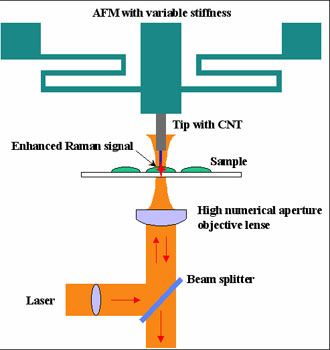| Jan 25, 2006 |
A nanoscanning platform for biological assay
|
|
(Nanowerk News) A nanoscanning platform is being developed by Prof. Sang-Gook Kim at the Micro & Nano Systems Laboratory (MNSL) at MIT. The work is described in a recent article in Nanotechnology. The paper describes how the variable stiffness is accomplished by engaging or disengaging electrostatically actuated clutches, in addition to the discussions on many possible benefits of the in-plane scanning platform.
|
 |
Schematic of TERS using an AFM with a CNT tip (Source: MIT) |
|
Despite its success as an imaging tool for nanostructures, the existing AFM system does not well reflect functionalities needed
for biological applications. Major problems of the current AFMs are slow imaging speed as well as poor compatibility of tip to
the soft surface of bio specimens. It has an in-plane structure with a variable stiffness and a carbon nanotube (MWNT) tip.
|
|
CNTs have been known as one of the ideal candidates for AFM tips because of their superior mechanical and
chemical properties, and they are also ideal for Tip Enhanced Raman Spectroscopy. The variable stiffness AFM
can work as a tool for imaging and placing the tip at the sub-nanometer proximity to a soft, molecular-scale
biological sample, which would enhance the Raman signals,. The metal coated CNT or CNT filled with Ag, Au, or
Cu, with a small diameter tip and high aspect ratio is ideal for TERS. It is expected that the CNTs’ plasmonic
behavior to photons and the variable stiffness of the in-plane probe can further enhance Raman signals, thereby
providing a high enough sensitivity for the imaging of single molecular structures, such as proteins.
|

